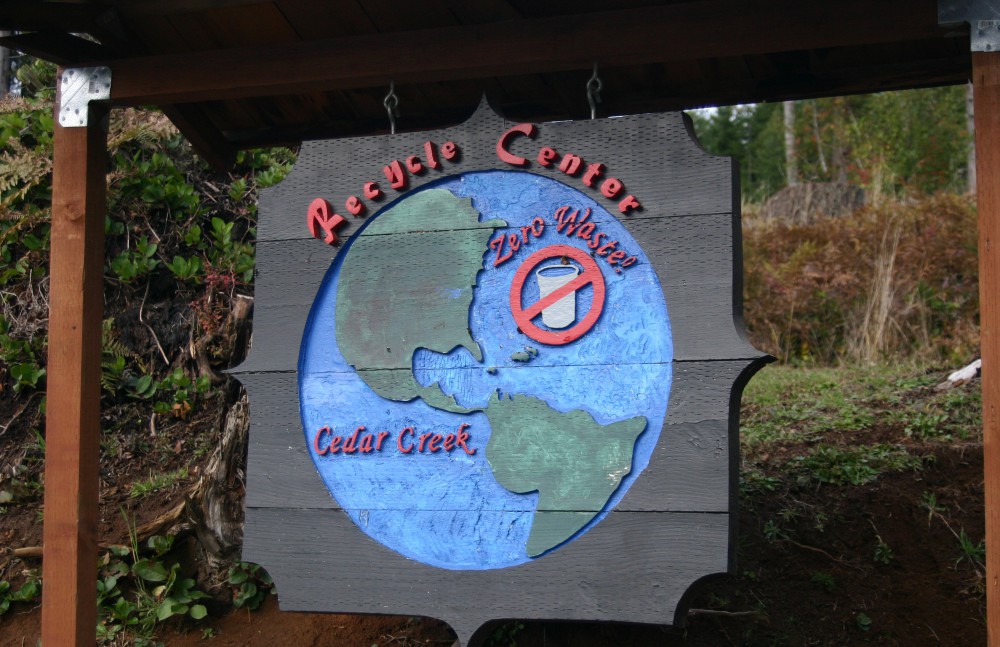Our Early Years
At Cedar Creek Corrections Center in 2003, the Washington State Department of Corrections (WA Corrections) and The Evergreen State College (Evergreen) created something wholly new. Inspired individuals from each institution were joined by community volunteers and other agencies to forge a partnership like you’ve never seen before.
Dan Pacholke, Cedar Creek’s superintendent, started composting and water catchment programs—he wanted to save money and create meaningful work for the men incarcerated at the minimum security facility. Dr. Nalini Nadkarni, a member of the faculty at Evergreen, asked for incarcerated people to join her in a study to grow native mosses, and Cedar Creek welcomed her proposal. In both cases, incarcerated technicians embraced the challenge, and proved highly capable, enthusiastic, and innovative partners.

Superintendent Dan Pacholke built a compost facility and water catchment with spare materials at Cedar Creek Corrections Center. He didn’t realize he also was building a new way to think about sustainability and prisons. Photo by WA Corrections staff.

Dr. Nalini Nadkarni shows off a bag of moss in the Cedar Creek greenhouse, 2004. Raymond Price stands behind her in the photo and figuratively as well: he volunteered his time to ensure that the new programs operated day to day. Photo by SPP staff.
These new efforts came with some unanticipated bonuses: greater cost savings than expected, press attention, and more and more folks who wanted to be involved. The prison was starting to feel different; It was becoming a more productive and positive environment. Sustainable operations, green jobs training, and bringing science and nature into prisons proved a winning combination, and that became SPP.
Early Heroes

Partners in SPP’s Oregon spotted frog rearing program converse at the entrance to Frogga Walla, the rearing facility. Photo by Benj Drummond.
Alongside Dan Pacholke and Nalini Nadkarni, many others brought inspiration to early SPP. Raymond Price was a volunteer at Cedar Creek who led early lectures, worked with staff and incarcerated technicians in the gardens, and kept the moss program and others on track day-to-day. Georgia Harvey was the prison’s Correctional Program Manager, and her knack for gardening meant that Cedar Creek was soon full of flower gardens and green spaces. Dan has said, “Georgia could literally look at something and make it turn green. She was a force to be reckoned with.” Tom Matthews, a local business advisor, helped Cedar Creek craft their first sustainability plan. He also helped SPP’s first Program Manager, Jeff Muse, develop the frog rearing area dubbed Frogga Walla.
With growing interest and efforts, SPP added new programs, new partners, and new prisons. A model took shape in which the needs and abilities of all participants shaped the programs. This meant that every initiative brought benefits to all involved: Corrections staff, Evergreen faculty and students, partner scientists, and the outside community.
Interagency Agreement
SPP was founded and still is a partnership between Corrections and Evergreen—SPP isn’t Evergreen, it’s WA Corrections and Evergreen together, plus the many, many partner organizations that help with the programs.
Following the success of pilot activities, the Sustainability in Prisons Project was formalized with an Interagency Agreement on July 1, 2008. The project fully expanded into three additional prisons, and the same time the range of programming grew to include science education, conservation biology, sustainable operations, and community contributions in all facilities. This growth represented partnerships with increasingly diverse partners and contributors. It also represented innovation and collaboration, and especially so in the face of budget or staffing challenges. SPP proved itself resilient and continued to grow.

Then-SPP Co-Director Dr. Carri LeRoy speaks at the ten year celebration at The Evergreen State College in 2013; Oregon white oaks were planted both at Evergreen and at Cedar Creek Corrections Center to recognize SPP’s founding partnership. Photo by Danielle Winder.
In 2013, SPP celebrated our 10-year anniversary.
For more on the story of SPP, see the TEDx talk from then-SPP Co-Director Dan Pacholke and SPP Graduate Research Assistant Andrea Martin. For the current shape of SPP, see About us.
